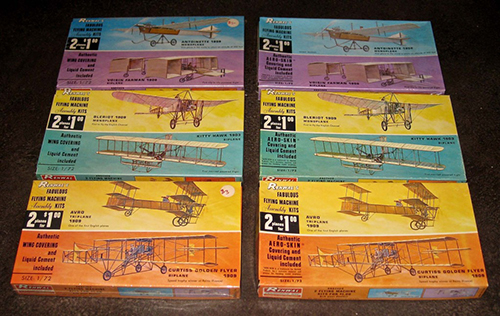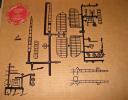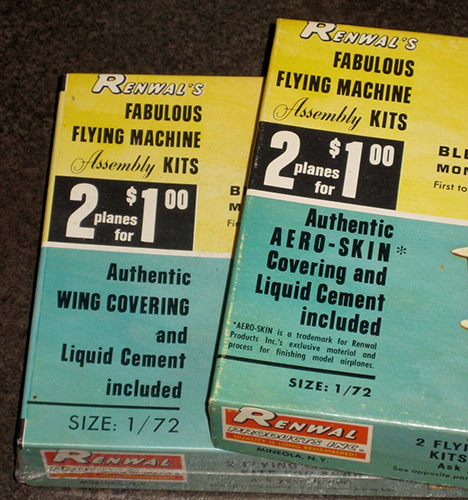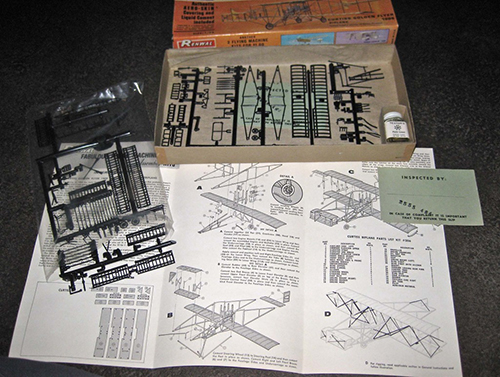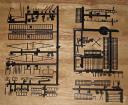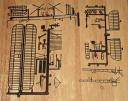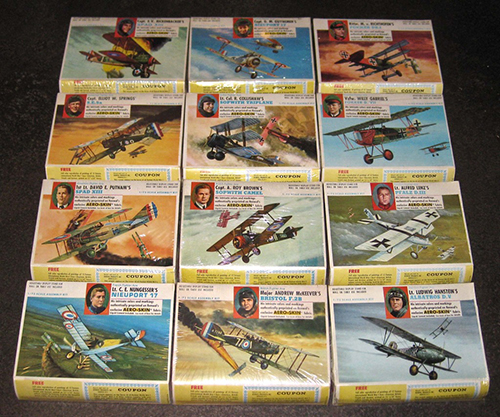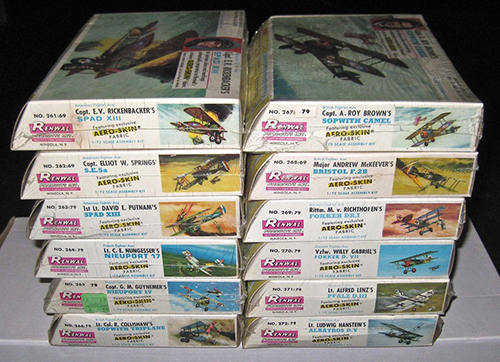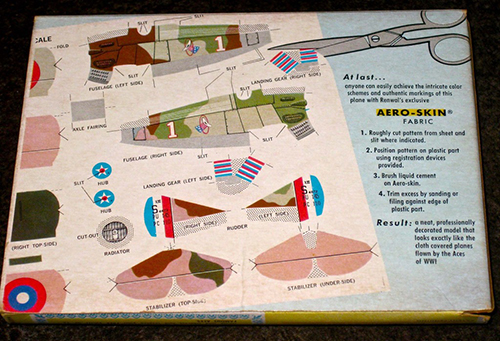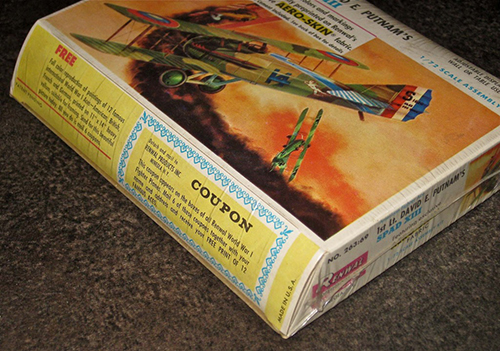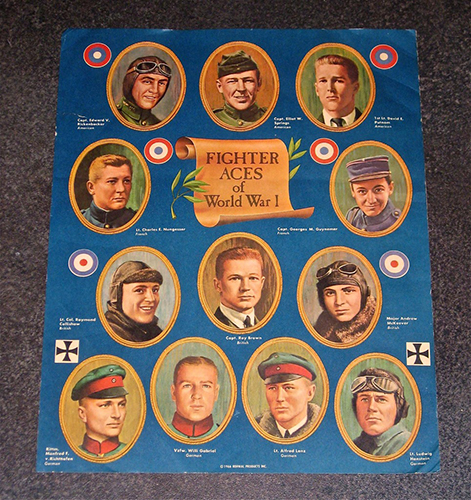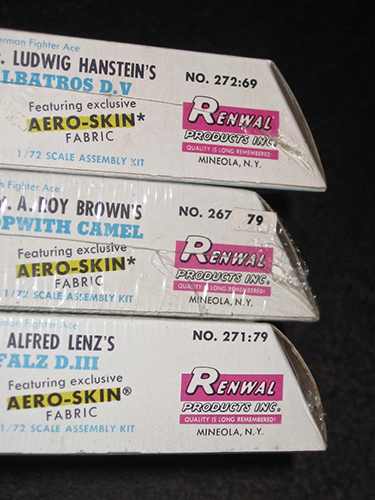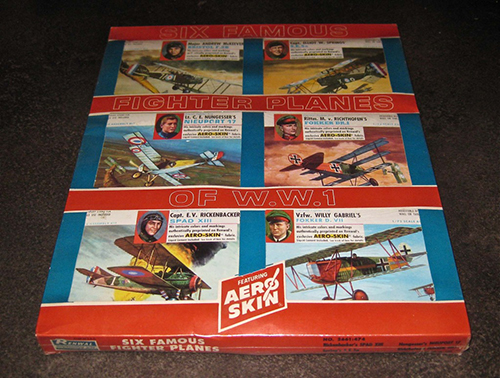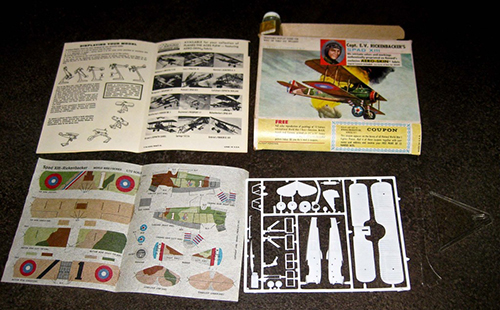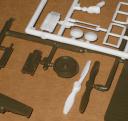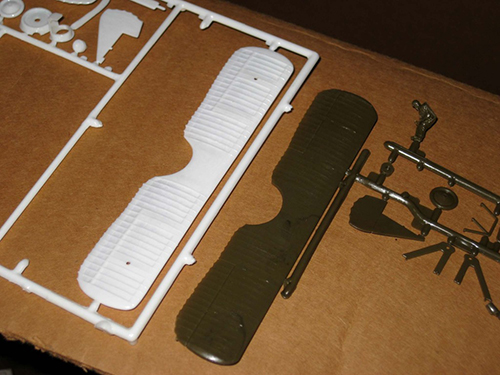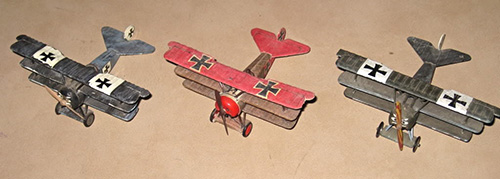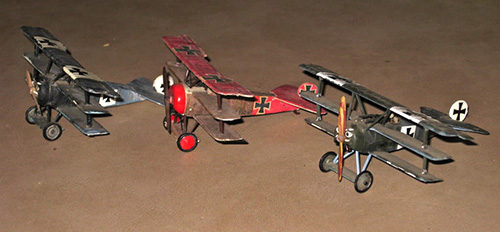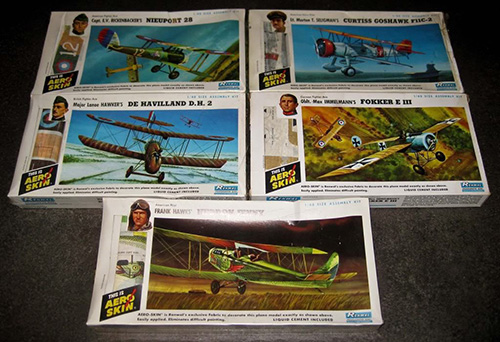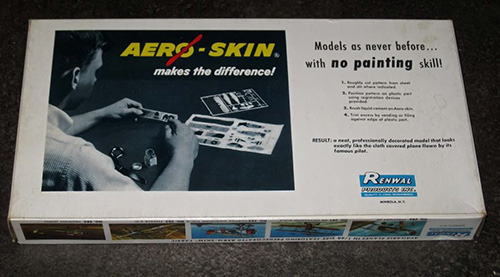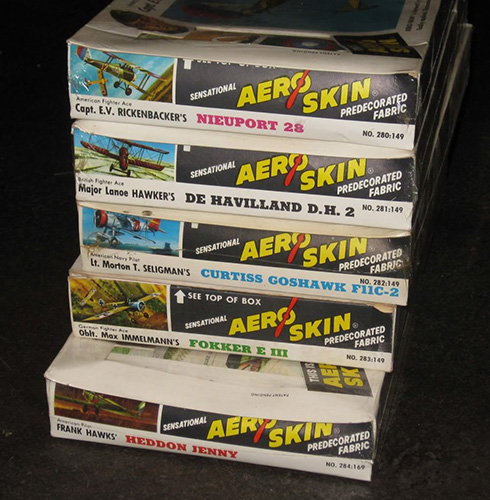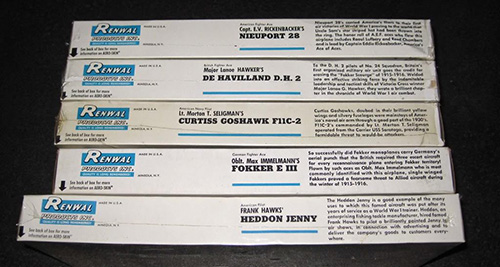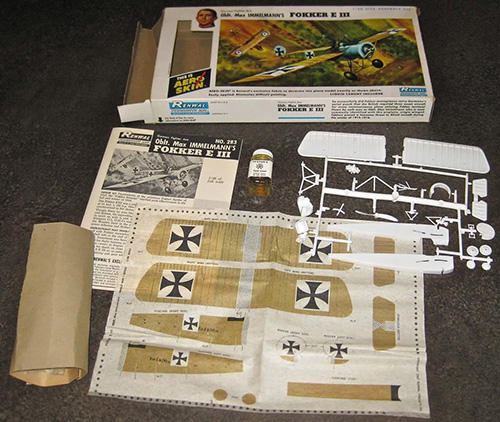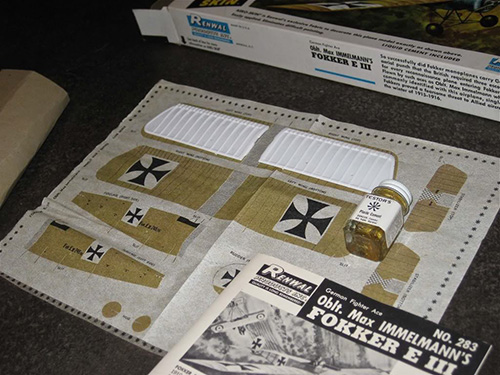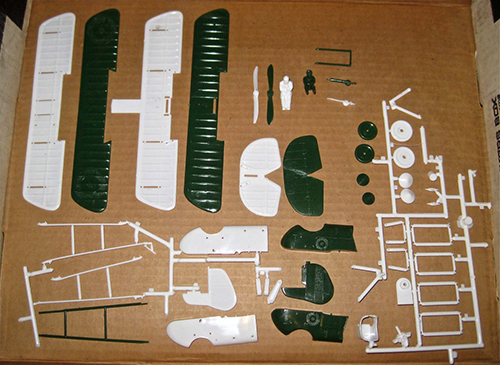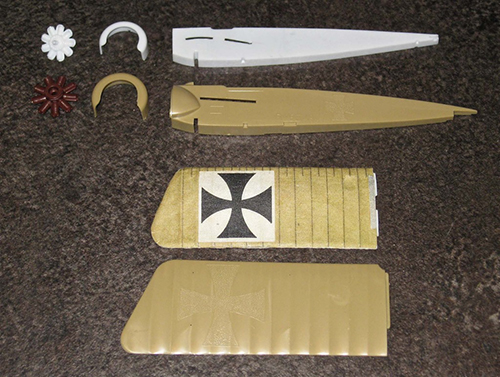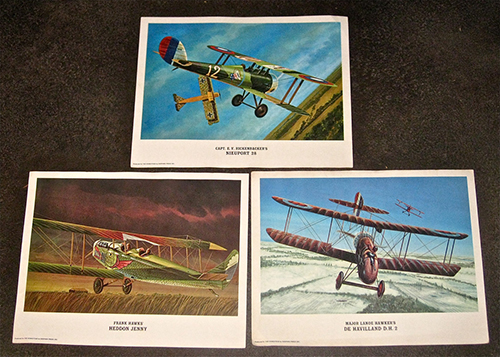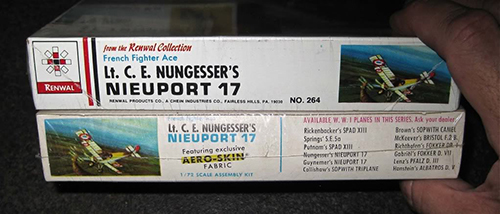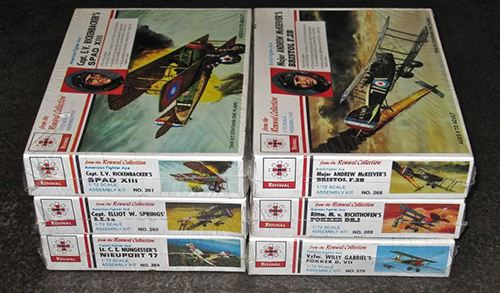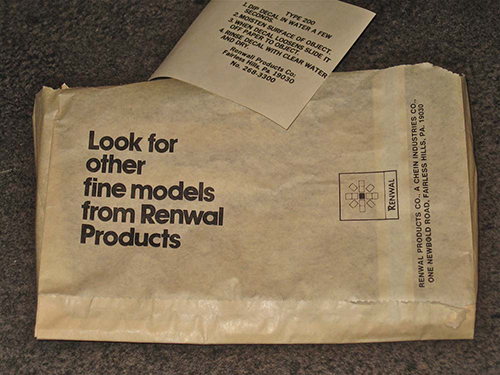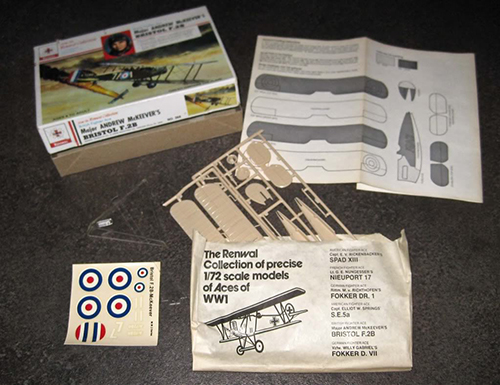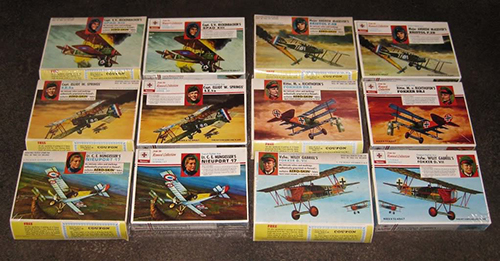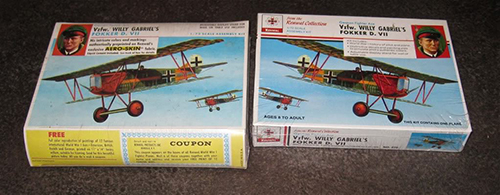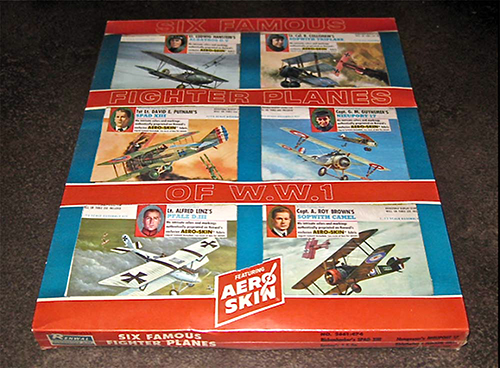By Brad Hansen
PART 1: Pre-War 2-in-1 Sets
Renwal had established an extensive line of kits by 1966. They had come out with a unique line of modern armor and military equipment, visible anatomical models, visible V-8s and chassis, nuclear submarines with detailed (if a bit fanciful) interiors and an older line of naval warships. They had introduced a large line of “Collectors Showcase” 1/48th scale cars, started a series of seven modern iterations of classic car designs (Renwal Revivals) plus a super-detailed 1/12 scale Mercedes Benz Gullwing and Ferrari.
Selected Renwal Kits (click any to enlarge)
Notable by their absence up to then were kits of aircraft. This changed in January of 1966 when Renwal issued their first series of model planes kits.
Proudly announced via large two-page ads in model magazines, Renwal called the series “Renwal’s Fabulous Flying Machine Assembly Kits,” a verbose title reminiscent of the previous year’s major motion picture: “Those Magnificent Men in Their Flying Machines.” Inpact of England was the model company associated with the film, but Renwal appeared to be catching a ride on a wave of interest in pre-World War One machinery.
Possibly inspired by the French Brifaut models, the Renwal kits each provided open frameworks of two pioneer aircraft molded in black, to be covered with “silk-span” tissue exactly like that found in flying model kits.
Here are a couple of comparisons between the earlier Brifaut Bleriot and Antoinette kits. The Brifaut is in dark brown to the left, Renwal in black to the right. You’ll note the parts are decidedly similar, but not the same- the Brifaut Antoinette is noticeably larger than the Renwal version, and the parts are arranged on the trees differently. It does look like Renwal may have used the Brifaut kits as inspirations for their own.
Brifaut & Renwal Bleriot and Antoinette Trees (click to enlarge)
I’ve never been able to figure out the large gap in the kit numbers, but, boy, these kits definitely retailed for $1.00—unless you could grab one for 73¢!
I have to admit a personal fondness for the packaging of this series. I really like the look of the boxes with the dramatic sky colors and the fine paintings of the planes. A model box needn’t always have explosions to be appealing. I have not been able to determine who the artist was.
The choice of craft was interesting, too, like the Voisin Farman and the tri-planiest triplane ever issued. These 2-in-1 boxes, being printed wraps (or ‘slicks’) over cardboard, have stood up well over the years, far better than the WWI Aero-Skin kits that followed. They’re still fairly common in the collecting world. Boxes were sealed in cellophane from the factory.
Within a year of their release, Renwal made a change to the information on the box top, highlighting the Aero-Skin process which they had gone to the trouble of trademarking. Both packaging variations can be seen in the first picture. The Aero-Skin name change probably coincided with the release of the WWI planes later in the year. The non-Aero-Skin packages appear to be a little rarer.
Change in Pre-War Box Design
Renwal Curtiss & Avro Contents
Above are the contents of the Curtiss Pusher and Avro Triplane box. Note the liquid cement included with every kit (now frequently missing); I will say that every intact bottle I’ve seen still has cement in it, unlike the corked bottles of cement often found in foreign-made kits of the same vintage. The tissue for covering the models is visible under the parts in the bottom of the box. This particular kit has two inspection slips, but only one bag for the Avro Triplane. The two inspection slips may not be an error; I’ve come across the same situation in other Renwal kits. Using a single bag to separate the parts of the two kits also appears to have been standard procedure. Renwal’s instructions are detailed but easy to follow.
Now for the fly in the ointment. If I may quote my book “WWI in Plastic,” they do not have the fragile translucent look of the real planes, but “the overly thick structures necessary in 1/72 scale, coupled with the poor choice of plastic color, made the finished models look like they were constructed out of two-by-fours dipped in creosote”. Somewhat harsh, but I think accurate. Perhaps if Renwal had just chosen a pale tan for the plastic color and supplied pale colored tissue for the covering the results would have been far more appealing. That being said, I really enjoyed building these kits when I was a kid and I don’t think it’s the liquid cement fumes talking! It was a novel experience, and glue-soaked fingers left no marring on the finished model. Here are shots of the parts for all six kits. The parts themselves are crisply molded, and have very little flash. I only wish they had made the trailing edges thinner.
Antoinette & Voisin Farman, Curtiss & AvroTriplane and Wright & Blerioit Parts
(click any to enlarge)
One other thing. In 1979 I received a letter from fellow kit collector Bill Slayton who sent the following list and numbers of what he described as individually packaged pre-war Aero-Skin kits:
202 Voisin Farman
203 Bleriot
204
205 Avro Triplane
206 Curtiss Golden Flyer
Now, in all the years since, this is the only reference I have ever come across to there being any packaging for these kits other than the 2-in-1 sets above. The numbering doesn’t conflict with any Renwal kits I know of, but I’ve never seen any other list like it. I don’t recall if Bill said he had some, or if he was looking at some printed catalog or price sheet. Anyway, it’s been over 30 years. I’m going to say this is probably a mistake, but will happily change my mind if something official ever turns up.
PART 2: 1/72 WWI Aces
PACKAGING
Renwal was very enthusiastic about the possibilities of their “Aero-Skin” process. Less than a year after releasing the Pre-War kits, they came out with a full 12 kits of WWI aircraft, designed specifically to take advantage of the Aero-Skin process. What set these apart from the previous series was the full color printing on the enclosed tissue.
Renwal WWI Aero-Skin Box Covers
WWI Aero-Skin Box Ends
The packaging of these kits is remarkable. Since they were so different, Renwal felt it necessary to clearly explain what Aero-Skin was, and why you might want to try it. Each box is kind of like a bullet-point presentation explaining and visually illustrating the whole concept. Seen here, Rickenbacker’s Spad XIII.
Spad Box Bottom
Each box showed what the included Aero-Skin looked like, along with a short description of how you used it. The cover art included a painting of the plane in question, as well as a portrait of the pilot who flew it. Renwal was never afraid of being educational. Seen below, David Putnam’s Spad XIII.
The one-piece boxes with opening long side panels, made of thin printed cardboard, were unusual in that they had one side panel at a 45 degree angle.
WWI Coupon
This side panel displayed a coupon to be saved; if six were sent in, you got this 14 x 11 poster of the portraits of the Aces, printed on “heavy vellum.” This example is the only one I’ve ever come across.
Renwal WWI Poster
The aircraft art was done by two illustrators. The following boxes were done by Gene Thomas, an artist who also did book covers: both Nieuports, Putnam’s Spad, Collishaw’s Sopwith Triplane, Gabriel’s Fokker DVII, and Lenz’s Pfalz DIII. Mort Künstler, now a very successful and well-known artist who specializes in painstakingly accurate paintings and portraits of American Civil War subjects, did Rickenbacker’s Spad, Spring’s SE5, McKeever’s Bristol F2b, Richthofen’s Fokker DrI, Roy Brown’s Camel and Hanstein’s Albatros DVa.
I don’t know which artist did the coupon portraits, or whether it was a third artist.
The kits first came out in late 1966, the same year as the film “The Blue Max”. I personally remember this because we went to see the movie, and when I got home I dove in and built Willy Gabriel’s Fokker DVII which I had received in a school Christmas gift exchange.
The kits initially sold for 69¢, going up a year later to 79¢ as shown by these taped on stickers. Probably in 1968 or 69 they had that price printed on properly. They were available from 1966 through 1969.
WWI Aero-Skin Price Variations
Aero-Skin Gift Sets
In 1969, Renwal broke the set of 12 into 2 sets of 6 and sold them as “Six Famous Fighter Planes of W.W.1.” The assortment of planes was not random; it was printed on the cardboard frame that enclosed and displayed the kits.
WWI Gift Set Kit Number
This is set 2661:474, a set I’ve seen three times. The second set, 2663:474, is one I’ve never seen, so I’m not certain if the cardboard sleeve is the same, or if it might even have a different name. The somewhat odd price number of “474” is derived by multiplying 79¢ x 6; usually when a company sells a set, they knock the effective individual price down; I would have thought a price of $4.00 would have been a better choice. Maybe that’s why these 6-in-1s are so rare.
THE KITS THEMSELVES
Though there were 12 kits in this WWI series, there were only 10 molds: The Spad XIII and Nieuport 17 both had two versions. Now, releasing 10 new kits all at once is a fairly impressive feat, and I think Renwal was able to accomplish this due to the unusual nature of the Aero-Skin kits.
Unlike the first Pre-War series, these WWI kits had solid wings and fuselages, but had deep recessed panels between the ribs, so that the paper fabric would “sag.”
Details like wing radiators, engine louvers and other tiny surface detail was not molded on; it was printed onto the fabric, along with an artistic representation of “shine.” This probably made it much easier to mold fuselages and such since they were mostly just smooth polished surfaces.
Secondly, and perhaps more importantly, it appears that Renwal decided to use existing kits as “three dimensional drawings” to save them the bother of fully developing original molds. And since these kits had to have the deep depressions between the ribs, no one could accuse them of simply copying other tooling. When one examines what was available at the time, it seems pretty clear that Renwal based the plastic parts on kits from other companies.
I wanted to do a part-for-part analyses of each of the kits. Frankly, I’ve only just started. Some of my Renwal kits are sealed and so I’m reluctant to open them, but here is one example.
Renwal Spad Contents
Here’s Rickenbacker’s Spad. Like all of the Aero-Skin WWI kits, it is molded in a hard white plastic, snuggly framed. A jar of Testors Liquid Cement, frequently missing, is taped to one of the box flaps. The nicely printed sheet of fabric displays the markings, as well as the missing detail (see the circular radiator on the fabric?) A clear plastic stand is provided with a pylon, scored to allow you to snap it at your chosen altitude to create a multi-level in-flight display.
If you compare the olive drab Revell Spad parts with the white Renwal parts, you can see the unmistakable similarities.
Renwal vs. Revell Spad (click to enlarge)
Note the fuselage panel with the guns molded on, a kind of unusual feature of the Revell Spad, and copied by Renwal.
Also, the Revell Spad had the less common early rounded wingtips which Renwal also mimicked; had Renwal created their own mold from drawings, they may have opted for the more typical squarish wingtips.
Also you can clearly see the unnatural look of the uncovered wings with their deep panels.
Renwal and Revell Spad Wings
Here we see the author’s 1967 vintage built-up Aero-Skin Fokker Triplane flanked on the left by his Airfix Triplane, and Revell Triplane on the right. It’s easy to see that the Renwal and Airfix Tripes are almost the same size, and sit very similarly. Also, the Revell kit had only just come out yet when Renwal issued theirs.
Even without doing a part-for-part comparison, I think we can safely assume that Renwal based their kits on the following other companies’ kits:
Spad XIII, SE5a, Nieuport 17, Sopwith Camel and Fokker DVII: Revell
Sopwith Triplane: Possibly Aurora, probably not Revell (theirs came out in late 1966 at about the same time as the Aero-Skin kits).
Pfalz DIII:
The surprising Pfalz DIII has always been the most desirable of all of the Renwal kits. It was the only injection molded 1/72 scale kit of this important plane until VeeDay made their limited production version in late 1980. A mainstream Pfalz DIII in this scale didn’t appear until Roden’s 2002 release!
Unfortunately, for all of their cleverness and great packaging, the resulting models just didn’t look as good as standard painted models. The printed details and painted “shine” on the aluminum-doped planes looked artificial. The wings were way over scale thickness. Also, one was limited to the markings they provided. And one was denied the pleasure of putting on decals.
But if part of the joy of a model is the sheer pleasure of assembling them, I will always say that the Renwal kits were a success; I remember having a lot of fun just putting them together. I may have to try again one of these days and see whether “grown-up” skill would make a noticeable difference. I know of at least one modeler who used the skin of a Renwal kit on a corresponding Revell kit with pretty nice results.
PART 3: 1/48 SCALE
In late 1967 Renwal issued their final Aero-Skin kits. Using the same techniques as the 1/72 kits, these were molded in 1/48 scale, and probably were the kits most likely to produce successful results.
Renwal 1-48 Aero-Skin Boxes
1-48 Aero-Skin Box Bottom
Now, having a big hole in a box made of thin cardboard is a bit of a problem. Opened examples of these kits are almost always a little mangled and frequently missing bits and pieces, especially since the parts were not inside a bag. (If you have one of these, I’d highly recommend sealing everything in a zip-loc bag.) And if the kits are still wrapped in their original cellophane, they can slowly squish over time; it’s not called “shrink wrap” for nothing.
1-48 Box Ends
Renwal went a little beyond WWI by including a Curtiss F11c Goshawk; also the Curtiss Jenny sports a post-WWI advertising paint scheme. The Jenny’s box is 13.75 inches long; the other boxes measure 12.5 x 6.5 x 1.5 inches.
Long Box Sides with History
Renwal 1-48 Fokker EIII Contents
Inside the boxes, the jar of liquid cement was stuffed inside a roll of cardboard padded with tissue; the Aero-Skin was wrapped around this piece of cardboard. The sprues are not as tidy as in the previous series, and parts are often knocked loose. Many a tail has gone sliding out into oblivion through a gap in the box flap.
1-48 Fokker EIII Wing Ribs
Again, it appears Renwal used other companies’ kits as ready-researched examples to simplify creation of their own kits. Interestingly, Renwal did not use the 1/48 Merit DH2 as a “model” for their own 1/48 DH2, as illustrated by the distinctly different shape of the fuselage, wings and other bits and pieces. Perhaps they didn’t have access to the Merit kit; it’s probably just as well, since it is not terribly accurate.
Renwal vs. Merit 1/48 DH2
Renwal vs. Revell DH2 (click to enlarge)
Also, note in particular Renwal’s spot-on re-creation and enlargement of Revell’s pilot figure.
Again, I’m not suggesting that all that Renwal did was to copy other kits without including their own refinements. They were smart enough to not use the Aurora Eindecker, (the K&B reissue appears below) which was noticeably over-sized at 1/40th scale, nor did they slavishly copy Revell’s Eindecker with its unusual 3-sided fuselage. They were certainly capable of creating their own tooling from scratch. I think they just took advantage of what was available from other companies to speed up the process of kit creation. By the way, this is a good shot of what a covered Aero-Skin wing looks like.
Renwal Aero-Skin Paintings
I don’t know the artists of the 1/48th artwork, but it would be a fair guess that it was Mort Künstler and Gene Thomas again. I haven’t been able to come up with a link between The Homestead, Shepard Press and Renwal. Perhaps these three prints are from artwork retained by one of the artists who released them on his own? This is pure speculation on my part.
Renwal finally ceased production of all Aero-Skin kits after 1969. They had certainly given it a good shot, but the non-reappearance of this process, at least from them, seems to indicate that it was basically a novelty to the modeling public. Or maybe they just felt it was time to move on to something different. I don’t have dates or anything official, but it appears Renwal changed hands about this time, and their future kit production and packaging suggests a re-direction of the company.
PART 4: Naked!
The somewhat lurid title of this installment belies the sad ultimate fate of the Renwal Aero-Skin series.
According to my few Renwal catalogs, what had for decades been Renwal Products Inc. of
By 1974, the company name had become Renwal Products Co. Inc., A Chein Industries Company (see top box).
Renwal Reissue and Original Nieuport 17
Reissue Box Ends
Upon release of the kits in late 1975, it became obvious that Renwal was not the company it had once been. The kits were unchanged except for the tan colored plastic. No Aero-Skin was included or even mentioned. Anyone attempting to build a model without tissue to cover the wings would have ended up with a peculiar looking plane, indeed. The trees were packed in a paper sleeve; decals, not terribly good ones, were included.
Renwal non-Aero-Skin Paper Envelope
Non-Aero-Skin Brisfit Contents
Renwal Reissues vs Original Aero-Skins
The original box art was retained, albeit modified; sometimes even reversed.
Reversed Box Art on the Fokker DVII
In summation, Renwal was a niche company that created some pretty unique lines of kits outside the norm produced by the larger manufacturers. Many of their have survived and actually stood up quite well. The Aero-Skins may not be remembered by modern modelers as anything more than a failed experiment, especially if your only criterion is the overall accuracy of the kit. But I will restate that for myself, the joy of building was as much a part of the equation as the finished product.
Finally, just for fun, a purely speculative picture of the other 6-in-1 set, 2663, albeit in the 2661 sleeve—like I said, the real one may look entirely different—this is only a fantasy.
Renwal 6-in-1 Fantasy Depiction of the Second Gift Set
Brad Hansen has been a model builder since the age of 5 when he built a Bachmann Robin kit while sailing with his family on board a transport ship from
One of 6 children of a U.S. Navy Carrier pilot, Brad grew up in an environment of models and airplanes. After years of building kits of almost every subject, he got hooked on W.W.I planes, building dozens of them in varied schemes, mostly in 1/72 scale.
When the availability of such kits seemed to dry up around 1970, Brad started collecting kits “for later.” In 1975 he stumbled on John Burns’ Kit Collector’s Clearinghouse, and decided to try to obtain one example of every W.W.I model kit ever produced. With the aid and encouragement of other enthusiasts, Brad self-published “W.W.I in Plastic: A Model Enthusiast’s Guide” in 1979. It was the first fully illustrated kit history, and the first to attempt to list the dates of production of kits. About 1250 copies were sold over the years, along with Updates published until 1983. Since then, Brad has continued collecting kits, and hopes to one day write a new version of “W.W.I in Plastic”. Rumors of his death are greatly exaggerated.

